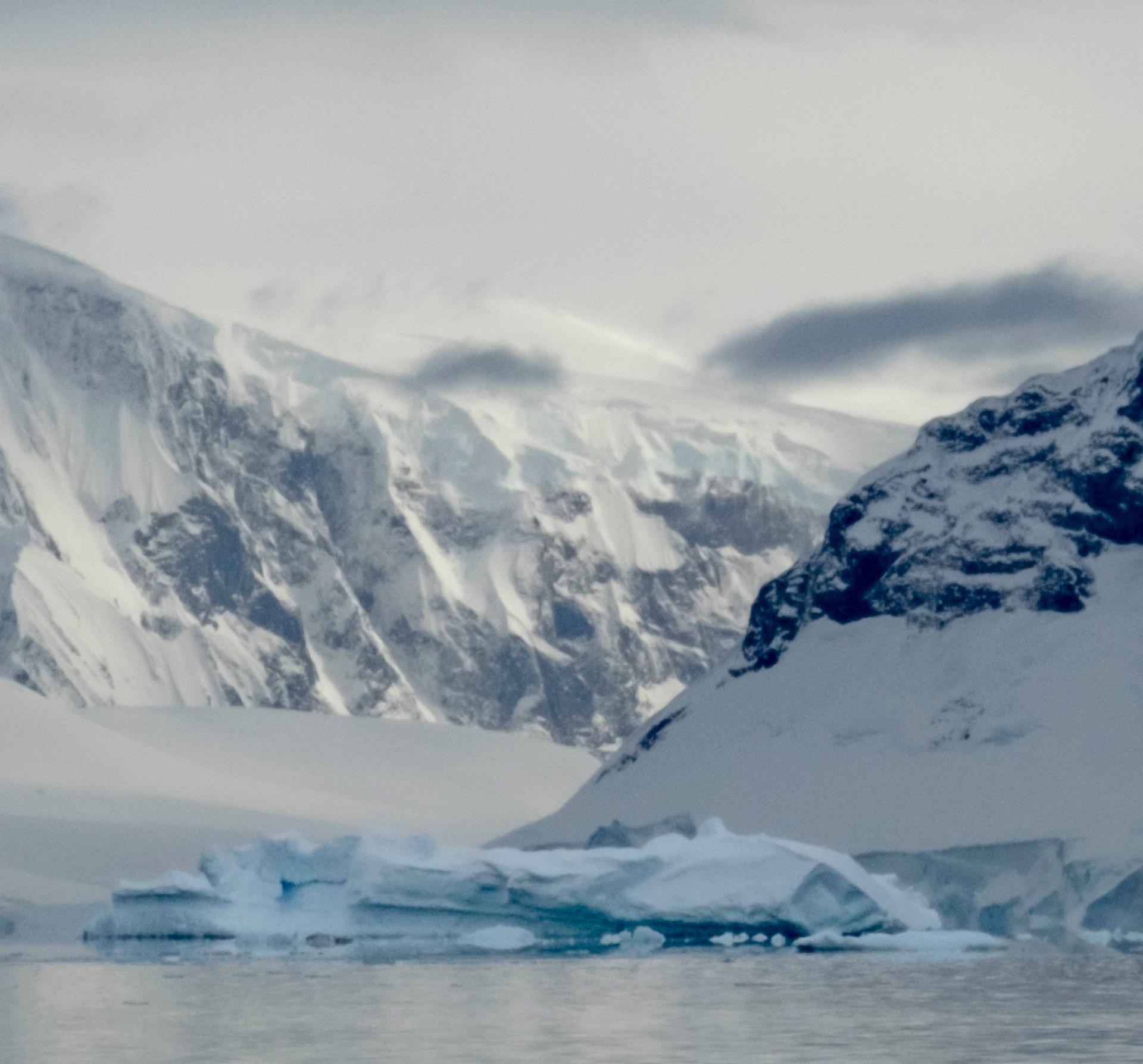
Frequently Asked Questions

Frequently Asked Questions

Frequently Asked Questions
#1 Where is Antarctica?
Antarctica is the southernmost continent on Earth.
Unlike the Arctic, which is an ocean surrounded by continents, Antarctica is a continent surrounded by a deep and cold ocean, the Southern Ocean.
The political boundary of Antarctica is the parallel 60º S; all the landmasses and ice shelves south of 60º S are part of Antarctica, and are ruled by the Antarctic Treaty.
The biological boundary of Antarctica is the Polar Front (or Antarctic Convergence), which is the area where the cold waters of the Southern Ocean meet with warmer waters of the Pacific, Indian, and Atlantic Oceans, and as the waters of the Southern Ocean are colder and denser, they sink beneath the other water masses.
#2 How many ways are there to go to Antarctica?
The common option to travel to Antarctica is by ship. Most of the expedition cruises to Antarctica and South Georgia Island depart from Ushuaia, Argentina, but there are also other gateways, such as Puerto Williams and Punta Arenas, in Chile, or Stanley (Puerto Argentino) in the Falkland/Malvinas Islands. The option from the Falklands/Malvinas is normally combined with a charter flight from Santiago de Chile.
Another way to go is by plane from Punta Arenas, which flies to King George Island (South Shetland Islands), and once there, joining the ship in Antarctica. At the end of the cruise, you fly back from Antarctica to Punta Arenas.
There are also combined options, flying from Punta Arenas and returning with the ship to Ushuaia, or vice versa.
To visit the other side of Antarctica, the Ross Sea region and the adjacent sub-Antarctic islands, departures are from New Zealand by ship.
If you are planning a more extreme expedition such as going to the interior of Antarctica, going to the Geographical South Pole, visiting colonies of Emperor penguins by plane, or climbing Mount Vinson, the first approach to Antarctica will be by plane. These more adventurous and exclusive options depart from Punta Arenas, Chile, and from Cape-Town, South Africa.
#3 Is it possible to fly to Antarctica?
Yes, there are certain voyages offering a wide range of combinations. From Fly over the Drake Passage both way to fly only one way and sail the other way. Also combining trips to Falkland/Malvinas and South Georgia.
#4 How much does it cost to fly to Antarctica?
Flying to Antarctica is a bit more expensive than sailing. You should expect an increase of about 20% more from other regular trips.
#5 What is the climate like in Antarctica?
Antarctica is the coldest, driest and also the windiest continent in the world. The lowest temperature on Earth was recorded in Antarctica; it was -89,2 ºC (-128.5 ºF) at the Russian Station Vostok in 1983. In 2018 there was a record of -97.8 ºC (-144 ºF) measured by a satellite system, however, this will not beat the record of 1983, as it was not measured on the ground.
There are three climatic regions in Antarctica:
The interior: This is the interior of the continent and it’s extremely cold, with summers around -35 ºC (-31 ºF) and winters around – 70 ºC (-94 ºF).
The coastal areas: These areas have milder temperatures and higher precipitation rates. The temperature in summer can vary between -5 ºC (23 ºF) to +5 ºC (41 ºF) and winter between -20 ºC (-4 ºF) to -35 ºC (-31 ºF).
The Antarctic Peninsula: This is the region, which has a warmer and also wetter climate. Precipitations vary in a range around 1000 millimetres per year; in the summer months you can experience temperatures from -2 ºC (28,4 ºF) to +5 ºC (41 ºF).
In the Ross Sea it can get significantly colder with temperatures down to -20 ºC (-4 ºF).
#6 What is the Temperature and Weather Like in the Antarctic Peninsula?
This is the region, which has the warmer and also wetter climate in Antarctica. Precipitations vary in a range around 1000 millimetres per year; and in the summer months you can experience temperatures from -2 ºC (28,4 ºF) to +5 ºC (41 ºF). On your voyage to the Antarctic Peninsula you can expect at least some rain or snow on occasion. The days tend to be cloudy, but the Sun can come out as well, as the weather tends to change a lot. You can also expect some wind on occasions.
#7 Will I be seasick on the ship?
Everyone reacts differently on board ships. To go to Antarctica the ship has to go through the famous Drake Passage, and that navigation can be rough (not all Drake Passage crossings are rough). Some people get sick, and some people don´t. From those getting sick, there are a percentage of people that will adapt to the movements after one or two days, other people take longer.
If you are prone to get seasick, please check with your personal doctor and bring preventative medication with you.
#8 How many scientific stations are there in Antarctica?
There are around 66 scientific stations between the permanent and the seasonal bases in Antarctica. There are more than 30 countries and 4,000 people that operate those stations during the summer time. That number is reduced to 1,000 people during the wintertime.
#9 How long are the shore excursions?
If the weather allows, in this type of voyages the aim is to have about two shore excursions per day.
Those shore excursions on average last about 2 to 3 hours. As a general rule, the smaller is the ship, the longer are the shore excursions. But sometimes, if the weather doesn’t allow, the tours can be shortened, or even cancelled. Flexibility and safety are paramount in the Polar Regions.
#10 Antarctic Adventure
What should I bring and what is required for the Antarctic Adventure trip?
For Snowshoe Walkers and Mountaineers:
Mountaineers must bring their personal sturdy mountain boots with sufficient ankle support and stiff sole. Mountain boots must be designed to fit crampons. Crampons will be supplied on board.
Please note: Participants can be excluded from the activity if they don’t bring proper mountain boots. Soft hiking boots and trainers are insufficient footwear.
Snowshoe walkers should bring mountain boots for comfort, grip and stability, (to protect the ankle); the gun boots provided on board are usually sufficient.
Clothing – (outer layer)
Windproof, waterproof, breathable jacket with hood
Windproof, waterproof, breathable pants/salopettes
Thermal Layer (underwear)
Synthetic/wool fleece/pile jacket/pull-on
Synthetic/wool fleece/pile pants/salopettes
Fleece vest or jacket
Base Layer (underwear)
Synthetic/wool thin top (long/short sleeves/zipped)
Synthetic/wool thin pants/long johns
Head
Synthetic/wool balaclava or Neck gaiter/scarf
Synthetic/wool hat
Windproof cap with peak/ear protectors
Sun hat
Facemask
Feet/Legs
Gaiters (Gamaschen)
Synthetic/wool thin/thick long socks
Thin synthetic under socks (against blisters)
Sleep: woollen clothes and socks
Hands
Gloves (Gore-Tex outside and Thinsulate inside, preferably ski/snowboard/mountain gloves with some grip)
Windproof over mitts
Synthetic/wool thermal mitts/ finger gloves
Down mitts
Thin (base layer) synthetic/wool mitts/gloves
Mitt/glove support (around neck)
Eyes
Facial protection
Sun glasses/glacier glasses with sides
Spare glasses/lenses
Skin and Hygiene
Sun block, sunscreen, fatty lip salve (no water)
Eye shield/Earplugs
Toilet/Hygiene kit, towel
Miscellaneous
Personal medication
25 Litre rucksack
1 Litre water bottle
Waterproof bag (for camera equipment)
Film or memory cards
#11 What is the weather like in the Falkland/Malvinas Islands?
The climate in the Falkland/Malvinas Islands is typically cool and influenced by the ocean. Annual precipitation is quite low and snow does not typically stay for too long. However, weather is quite unstable and minimal amounts of rain fall on a regular basis.
Although summer can be as warm as 24º C (75 ºF) the average high temperature in January and February is around 9 ºC (48º F). The average high temperature during the winter is 2º C (36º F).
#12 What is the Capital of the Falkland/Malvinas Islands?
As the Falkland/Malvinas, South Georgia, and South Sandwich islands are in dispute between the United Kingdom and Argentina, there are two answers to that question. For the United Kingdom and the residents of the Falkland/Malvinas, the capital is Port Stanley (Puerto Argentino). However, for Argentina, the Capital of Malvinas is the city of Ushuaia, in Tierra del Fuego. Stanley (Puerto Argentino), being or not the capital, is the largest settlement of the archipelago and the main shopping hub.
#13 How Many People Live in South Georgia?
South Georgia has no permanent population. All the inhabitants of the island are there for a period of time. Part of the residents live in Grytviken and they take care and work in the museum and the post office, the rest of the population live in King Edward Point and on the research station on Bird island, and they are British Antarctic Survey (BAS) personnel.
During the summer, the population can rise up to 40 people due to an increased BAS presence.
#14 What type of wildlife can we find in the Falkland/Malvinas islands?
The wildlife you can find in Falkland/Malvinas is quite similar of the one you can find in Patagonia. There are over 60 bird species that breed on the islands of the archipelago, including five species of penguins: King penguins, rockhopper penguins, magellanic penguins, gentoo penguins, and macaroni penguins. Also the largest breeding population of black-browed albatross is found on the islands.
Elephant seals and sea lions are resident breeders, and peale s dolphins, commersons dolphins, leopard seals, and orcas and other whales are frequently seen in the surrounding waters.
#15 What kind of wildlife can I find in South Georgia?
South Georgia is one of the places with the greatest density of wildlife in the World. It is one of the most important penguin and seabird breeding areas in the Planet, and the rich ocean waters surrounding the island play a major part in it.
There are around half a million pairs of King penguins; St. Andrews and Salisbury Plain are known to host some of the biggest rookeries in the World. There are also about 3 million pairs of macaroni penguins, and gentoo penguins and chinstrap penguins can also be found in smaller numbers.
The populations of Antarctic fur seals and southern elephant seals have recovered incredibly well after the slaughter occurred at the beginning of the 1800’s and 1900’s. Now you can find these marine mammals all over the island.
After the successful rat eradication project, seabirds are thriving on the island and there is an estimated population of well over 10 million individuals!
South Georgia is considered to be the Serengeti of the Southern Ocean... or even more!
#16 How long does it take to reach South Georgia?
South Georgia is located 1260 nautical miles (2028 km) from Ushuaia, Argentina, and 900 miles (1500 km) from Stanley, Falkland/Malvinas islands. There is no airport, so the only way to reach South Georgia is by ship. Cruise ships visit South Georgia from October to April. The usual route is starting at Ushuaia (although, at the beginning of the season there are some cruises starting at Puerto Madryn, Argentina or Montevideo, Uruguay), visiting Falkland/Malvinas first and then set sail to South Georgia, taking around 2 and a half days sailing from Stanley (Puerto Argentino). Few voyages sail directly from Ushuaia, and it takes approximately 4 days sailing. All this varies, of course, depending on the speed of the ship and the sea conditions that you encounter during the navigation.
#17 When is the best time to visit South Georgia?
Deciding when is the best time to visit South Georgia really comes down to what you want to experience. First of all, we must say that no matter when you visit South Georgia, it will always have something spectacular to offer you! Due to the nature of the King penguin breeding cycle, no matter when you visit South Georgia, you will always see them!
Cruise ships visit South Georgia from October to April. If you go at the beginning of the season (October-November) you will find some species coming ashore to begin their nesting and mating rituals. This is the time when elephant and fur seal pups are born and elephant seal males can be seen fighting aggressively over the breeding territories.
In December and January days are longer as you are at the pick of the Austral summer. The beaches will be full of wildlife, to the point that it could be possible that some landings have to be cancelled due to the high concentration of wildlife on the beach. This is the time (especially in December) when Antarctic fur seals males became very aggressive and protective of their territories. Prion island usually opens again by the second fortnight of January and it will give you the chance to see wandering albatross on their nesting sites.
During February and March is a good chance to find whales, stay on deck looking for humpback, fin, southern right whales, and even orcas in the waters near the island. The fur seal pups will walk playfully on the beach. The temperature may start dropping considerably during the night.
THE POLAR TRAVEL COMPANY LLC
USA
8175 NW 12 ST #120, Doral, FL 33126
Miami - Dade, Florida
Tel: +1 (786) 321-5654
WhatsApp: +1 (786) 705-2241
Email:
travel@thepolartravelcompany.com
MULTIMEDIA
LITERATURE
PHOTO GALLERY
VIDEO GALLERY
FAQ
ABOUT US
BLOG/NEWS



© 2020 The Polar Travel Company | All rights reserved | Terms & Conditions
THE POLAR TRAVEL COMPANY LLC is registered with the State of Florida as a Seller of Travel. Registration No. ST42392.
| Write us via WhatsApp |